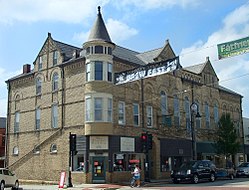
Mount Horeb is a village in Dane County, Wisconsin,. The population was 7,754 at the time of the 2020 census. It is part of the Madison Metropolitan Statistical Area.

Carnegie Hall is a concert venue in Midtown Manhattan in New York City. It is at 881 Seventh Avenue, occupying the east side of Seventh Avenue between West 56th and 57th Streets. Designed by architect William Burnet Tuthill and built by industrialist and philanthropist Andrew Carnegie, it is one of the most prestigious venues in the world for both classical music and popular music. Carnegie Hall has its own artistic programming, development, and marketing departments and presents about 250 performances each season. It is also rented out to performing groups.

Old Pasadena, often referred to as Old Town Pasadena or just Old Town, is the original commercial center of Pasadena, a city in California, United States, and had a latter-day revitalization after a period of decay.

The Ludus Magnus was the largest of the gladiatorial schools in Rome. It was built by the emperor Domitian in the late first century C.E., alongside other building projects undertaken by him such as three other gladiatorial schools across the Roman Empire. The training school is situated directly east of the Colosseum in the valley between the Esquiline and the Caelian hills, an area already occupied by Republican and Augustan structures. While there are remains that are visible today, they belong to a reconstruction that took place under the emperor Trajan where the Ludus plane was raised by about 1.5 metres. The Ludus Magnus was essentially a gladiatorial arena where gladiators from across the Roman Empire would live, eat, and practice while undergoing gladiatorial training in preparation for fighting at the gladiatorial games held at the Colosseum. The Colosseum was where Gladiators would go to fight their opposition.
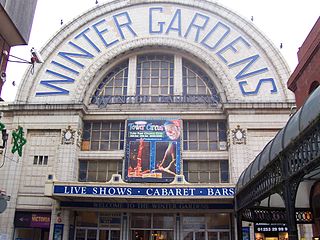
The Winter Gardens is a large entertainment complex in Blackpool, Lancashire, England, which includes a theatre, ballroom and conference facilities. Opened in 1878, it is a Grade II* listed building, operated by Blackpool Entertainment Company Limited on behalf of Blackpool Council, which purchased the property from Leisure Parcs Ltd as part of a £40 million deal in 2010.

The Main Street Historic District in Fort Atkinson, Wisconsin, United States, was placed on the National Register of Historic Places in 1984. The district is composed of 51 buildings on or within a block of Main Street.
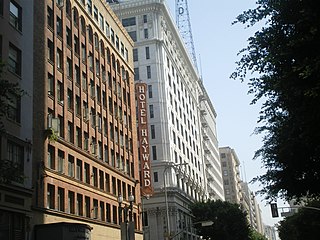
Spring Street in Los Angeles is one of the oldest streets in the city. Along Spring Street in Downtown Los Angeles, from just north of Fourth Street to just south of Seventh Street is the NRHP-listed Spring Street Financial District, nicknamed Wall Street of the West, lined with Beaux Arts buildings and currently experiencing gentrification. This section forms part of the Historic Core district of Downtown, together with portions of Hill, Broadway, Main and Los Angeles streets.
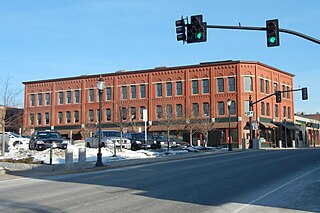
The Masonic Block is an historic commercial block in Reading, Massachusetts. This three story brick building is distinctive in the town for its Renaissance Revival styling. It was built in 1894 by the local Reading Masonic Temple Corporation, and housed the local Masonic lodge on the third floor. The building was listed on the National Register of Historic Places in 1984.

The Newport Opera House is a historic civic building and performing arts venue at 20 Main Street in the heart of downtown Newport, the county seat of Sullivan County, New Hampshire, United States. Built in 1886, it was billed as having the largest stage in New England north of Boston, and continues to serve as a performance venue today. The building was listed on the National Register of Historic Places, as "Town Hall and Courthouse", in 1980, for its architecture and civic roles, and is a contributing property in the Newport Downtown Historic District.

The Metropolitan Opera House is an opera house located on Broadway at Lincoln Square on the Upper West Side of Manhattan in New York City. Part of Lincoln Center, the theater was designed by Wallace K. Harrison. It opened in 1966, replacing the original 1883 Metropolitan Opera House at Broadway and 39th Street. With a seating capacity of approximately 3,850, the house is the largest repertory opera house in the world. Home to the Metropolitan Opera Company, the facility also hosts the American Ballet Theatre in the summer months.

The Robert M. Lamp House is a residence built in 1903 two blocks northeast of the capitol in Madison, Wisconsin, designed by Frank Lloyd Wright for his lifelong friend "Robie" Lamp, a realtor, insurance agent, and Madison City Treasurer. The oldest Wright-designed house in Madison, its style is transitional between Chicago school and Prairie School. In 1978 the house was added to the National Register of Historic Places.

The Historic Walden United Methodist Church is located on West Main Street in Walden, New York, United States. It was desanctified in 2013 and sold by the congregation on November 24, 2014. The current location is at 1206 New York State Route 52, Walden, New York, United States. Ground was broken on a new House of Worship in September 2019 and was completed in 2022.

The Hyman–Brand Building, often referred to as just the Brand Building, is located at the corner of South Galena Street and East Hopkins Avenue in Aspen, Colorado, United States. It is a two-story stone building erected in the late 19th century. At different stages in the city's history, it was owned by an entrepreneur who used the building in a way that redefined the city for that time. In 1985, it was listed on the National Register of Historic Places.

The Oregon Masonic Hall or Oregon Masonic Lodge is a highly-intact 1898 building in Oregon, Wisconsin - with the second story finely decorated using cream and red brick and red sandstone. It was listed on the National Register of Historic Places in 1992.

The Onon B. and Betsy Dahle House a Greek Revival-styled house built in 1864 in the community of Daleyville, Wisconsin in the town of Perry, Wisconsin. It was added to the National Register of Historic Places in 2008.

The Wakefield Town Hall and Opera House is a historic municipal building at 2 High Street in the Sanbornville village of Wakefield, New Hampshire. Built in 1895, it is a prominent local example of Romanesque architecture, and has housed civic and social activities since its construction. The building was listed on the National Register of Historic Places in 2007, and the New Hampshire State Register of Historic Places in 2002.

The Herman B. and Anne Marie Dahle House is a very intact Classical Revival home built in 1911 in Mount Horeb, Wisconsin for one of the city's prominent citizens.

The South Main Street Historic District is a surviving collection of eleven commercial buildings built from 1877 to 1915 in the old downtown of Oregon, Wisconsin, plus the WWI memorial. It was added to the State and the National Register of Historic Places in 2000.

The Omro Village Hall and Engine House, built in 1896, was the first centralized municipal building in Omro, Wisconsin, and the seat of local government for 70 years. In 1997 it was added to the National Register of Historic Places for its intact Late Victorian architecture and its role in the community.
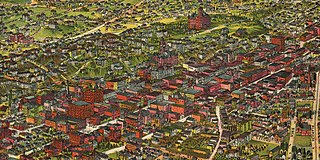
The late-Victorian-era Downtown of Los Angeles in 1880 was centered at the southern end of the Los Angeles Plaza area, and over the next two decades, it extended south and west along Main Street, Spring Street, and Broadway towards Third Street. Most of the 19th-century buildings no longer exist, surviving only in the Plaza area or south of Second Street. The rest were demolished to make way for the Civic Center district with City Hall, numerous courthouses, and other municipal, county, state and federal buildings, and Times Mirror Square. This article covers that area, between the Plaza, 3rd St., Los Angeles St., and Broadway, during the period 1880 through the period of demolition (1920s–1950s).
